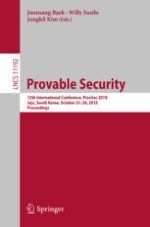2018 | OriginalPaper | Buchkapitel
Towards Static Assumption Based Cryptosystem in Pairing Setting: Further Applications of DéjàQ and Dual-Form Signature (Extended Abstract)
verfasst von : Sanjit Chatterjee, R. Kabaleeshwaran
Erschienen in: Provable Security
Aktivieren Sie unsere intelligente Suche, um passende Fachinhalte oder Patente zu finden.
Wählen Sie Textabschnitte aus um mit Künstlicher Intelligenz passenden Patente zu finden. powered by
Markieren Sie Textabschnitte, um KI-gestützt weitere passende Inhalte zu finden. powered by
